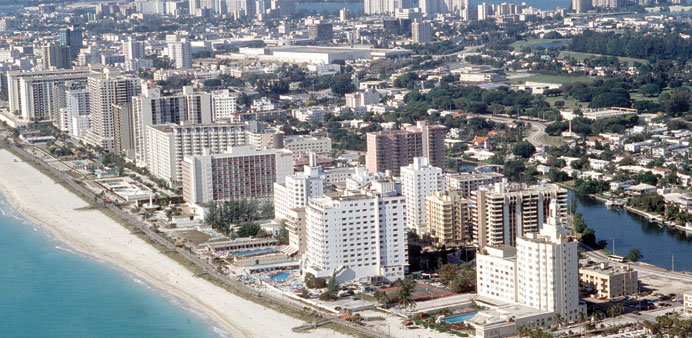Miami Beach with its white sand and transparent water, has become a trendy spot for the rich and famous.
By Daniel Garcia Marco
Miami Beach has become one of the trendiest spots in the world attracting the likes of rich heiress Paris Hilton and countless other international celebrities and film stars to tan on its pristine beaches.
The resort has a thriving night scene as well; not just sun-tanned bodies in the daytime but also those same bodies swaying in fashionable outfits in the evenings in clubs and other venues.
It is second only to Los Angeles in terms of VIP density per square metre.
The most exclusive location in the Miami Beach area is Star Island, an enclave for the rich and famous with restricted access. It is a tourist attraction to be wondered at from afar for everybody else.
The so-called beautiful people enjoy their homes, discretion and privacy on Star Island much as the Chicago gangster Al Capone did in the 1920s, the period when the resort experienced its first boom as a vacation destination.
Miami Beach started off as just a plain sandbar off the coast of Florida. It was bought by entrepreneur Henry Lum and his son Charles from the US federal government in 1870 as a development site.
The rich and famous keep second homes in Miami Beach because of the weather.
It doesn’t matter whether it is January or February or March: The beaches are white and the water transparent, peaceful and temperate all winter long. And, all of those things trump the not minor threats from hurricanes during the summer-fall storm season.
Beautiful architecture is another important feature that adds to the enchantment of Miami Beach. Many small hotels in the Art Deco section, with its low buildings in pastel tones, have recently been renovated.
“Architecture defines our city,” said Michael Kinerk, president emeritus of the Miami Design Preservation League.
It was Miami Beach’s architecture that drew visitors back in the 1970s after many years in which the hotels had been decaying and Miami itself was swamped by an influx of half a million Cubans fleeing Fidel Castro’s revolution in Cuba, turning it into the Latin capital of the US.
The area of Miami Beach which celebrities and wealthy tourists enjoy today — thanks to investments made in the 1980s and 1990s to salvage boutique hotels — is the same that soldiers, heading to World War II, “occupied” while training 1942-1945.
Nearly 500,000 men, among them the US leading man Clark Gable, took over 300 hotels and buildings as residences and practice centres before World War II.
It came to be called “the nicest training camp in the US.”
The beach is fairly low-key, except for Ocean Drive, the main avenue, which is filled with expensive hotels and restaurants.
In the evening it becomes one huge entertainment spot, offering an array of leisure activities, music and clubs, but all the different establishments are in the same general area.
Miami Beach, like many other resorts, takes a relaxed approach to life.
Freedom and tolerance prevail.
However, alcohol is banned in most entertainment venues and so patrons are served fruit cocktails instead.
“This is the place to be,” is a common phrase heard among residents, real estate agents and waiters.
Some visitors were simply passing through, but stayed forever.
“I did not like it much at first, but it gradually drew me in,” said Juan Carlos Arias, a 33-year-old Spaniard who expressed an opinion voiced by many.
Not everyone fits in to the culture of seeing and being seen, but there is more than meets the eye.
“There is more culture here than one would believe,” said French citizen Sophie Dulles, 34, who gets around on bicycles that are provided by authorities for a small monthly rental fee.
And for art lovers there is the Art Basel Miami Beach event. One of the world’s most important contemporary art exhibitions, comes to Miami Beach once a year to delight of those who want more than sun, sand and lively night-life.
Miami Beach confirms and contradicts the stereotype. — DPA



